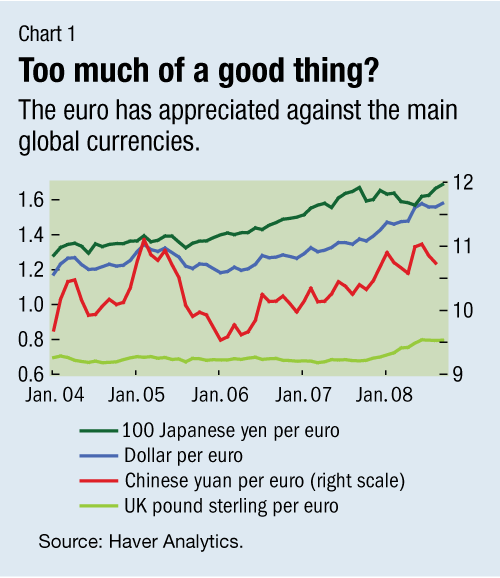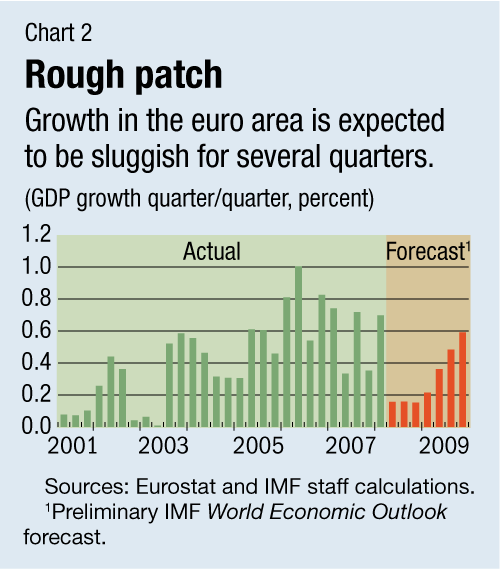
Typical street scene in Santa Ana, El Salvador. (Photo: iStock)
IMF Survey: Euro Marks Milestone As Currency Union Faces Slowdown
August 5, 2008
- Monetary union a success, but economic union remains a work in progress
- Euro area faces decelerating growth and uncomfortably high inflation
- Strong political leadership needed to improve financial stability arrangements
Ten years ago, heads of state of the European Union (EU) gave the go-ahead for the third stage of Economic and Monetary Union (EMU), approving the introduction of the euro in 11 EU member states on January 1, 1999.

Much depends on how labor costs and inflation expectations evolve in the euro area. (photo: Uwe Zucchi/dpa/Corbis)
Euro's tenth anniversary
Since then, four more EU member states have adopted the currency, and Slovakia is set to follow at the beginning of 2009.
Distinct success
On the occasion of its annual review of the euro area's economic policies, the IMF's Executive Board hailed this anniversary, noting that monetary union has been a distinct success and that EMU's policy frameworks have turned the euro area into a zone of stability in the international economy.
But the IMF's Executive Directors also emphasized that economic union remains a work in progress: the euro area's productivity growth has been disappointing and there are wide economic disparities among the 15 countries that are using the euro today.
Beset by shocks
A number of developments are compounding these structural challenges. The euro area economy is under strain following a series of shocks, including from the commodity and financial markets. Oil prices have recently hit record highs, financial stocks have fallen substantially, borrowing costs and credit default spreads have risen, and term spreads in money markets remain at elevated levels.
Most of these shocks are global, but the euro area faces the specific problem that the euro has borne a disproportionate burden of the dollar's depreciation (see Chart 1). IMF staff estimate that the real effective exchange rate of the euro is now at least ten percent above what is warranted by medium-run fundamentals.

Although the euro area economy initially held up well, it now faces a combination of uncomfortably high inflation and decelerating activity. Inflation has reached an EMU record of 4.1 percent (although it remains below two percent if one excludes energy and food), and growth is rapidly losing steam. IMF staff expects growth to remain weak for the next few quarters before reaccelerating toward trend during 2009 (see Chart 2).

Difficult policy choices
In this setting, monetary policy has to balance the risk that the current price shock could result in a generalized and durable increase in inflation, against the prospect that slowing growth will gradually start exerting downward pressure on prices and wages.
Much depends on how labor costs and inflation expectations will evolve. The wage moderation seen over the past decade has been a consistent positive surprise, indicating that past labor market reforms have improved the trade-off between inflation and employment. This is reassuring, as is the absence of signals that inflation expectations are becoming unhinged. Nonetheless, risks of second-round effects remain.
The ongoing financial turmoil complicates the policy challenge: financial conditions have tightened substantially since last summer and the financial environment remains under strain. In this context, monetary policy tightening carries risks of its own. After raising its main policy rate to 4.25 percent on July 3, the European Central Bank (ECB) announced that it would continue to monitor all developments very closely and do what is necessary to deliver price stability—the single needle in its policy compass. IMF staff are of the view that policy rates are best kept on hold.
Managing the credit crunch
The ECB has played a crucial role in containing the impact of the global financial turmoil, within a liquidity management framework that has proved itself flexible and robust. The key challenge going forward is to restore the depth and orderly functioning of interbank markets. In this regard, the ECB is rightly keeping its operational framework under continuous review, notably with respect to the collateral it accepts.
But the ECB's liquidity operations cannot address the basic problems behind the turmoil, and the outlook for financial stability remains highly uncertain. While the euro area's banking system is essentially sound, its operating environment and profitability have been adversely affected.
If there is a silver lining to the turmoil, it is perhaps that it has added impetus to the debate on the EU's financial stability framework. The EU's commitment to build a single market for financial services requires a move toward greater joint responsibility and accountability for financial stability. Important progress has recently been made toward this objective, including the adoption of common principles for cross-border crisis management and a related Memorandum of Understanding that is intended to put these principles into practice.
However, national financial stability frameworks will need to be aligned with these principles. This will require strong political leadership—of the kind that led to the creation of the euro ten years ago.
A disciplined approach
Financial and other stresses should not divert attention from the sound fiscal and structural policies that remain key to the euro area's long-term economic performance.
The euro area and its member states are best served by sticking to a rules-based fiscal policy framework—as provided by the Stability and Growth Pact (SGP). The SGP has helped deliver greater fiscal discipline, but further progress in lowering government deficits and debt is key to meeting the costs of population aging, which are set to mount rapidly after 2010.
Moreover, past and ongoing structural reforms are bearing fruit, most notably in raising labor utilization. To capitalize on this and build a prosperous economic union, structural policies will need to focus in a coordinated way on still-sheltered services markets and on countries' ability to adjust to shocks.
In sum, the euro area has much to celebrate, as it ponders the first 10 years of its existence. And it is well positioned to head off the risks stemming from the continued fallout of the credit crunch—provided it makes the right policy choices.
This article is based on the Euro Area IMF staff report and associated documents (http://www.imf.org/external/np/sec/pn/2008/pn0898.htm).
Comments on this article should be sent to imfsurvey@imf.org


